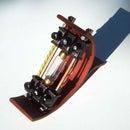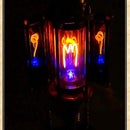Introduction: Steampunked Laboratory Lamp
Hi everybody
The sucess of the "steampunk creators diary" presented at my last instructable, encouraged me to continue on this way. At the end of this instructable you will find the complete steampunk creators diary of this instructable-projekt.
So today I want to show you the making of my "Steampunked-Laboratory Lamp" which is dedicated to the famous inventors in the victorian era: NikolaTesla and Thomas A. Edison.
Nikola Tesla was a brilliant and eccentric genius whose inventions enabled modern-day power and mass communication systems.
His former boss, Thomas Edison, was the iconic American inventor of the light bulb, the phonograph and the moving picture.
The two feuding geniuses waged a "War of Currents" in the 1880s over whose electrical system would power the world — Tesla's alternating-current (AC) system or Edison's rival direct-current (DC) electric power (see also the poster at the gallery).
As a first impression you can watch this short video and you can also listen to my explanations for the first time:
Let me make one personal request before I start with this instructable:
On my blog www.dampfkraftlabor.de/ you will find a 3D globe (from revolvermaps) spinning around. Every visitor leaves an eternal dot on the globe. So if you like you can leave "your own dot" as a follower of mine, That would be verry great With a big Thanks for following
Yours Aeon Junophor
This steampunked laboratory lamp runs with both types of current.
- The neon bulb ist powered by AC and the shell looks like a part of an electric engine.
To drive the neon bulb with high voltage see this instructable .
-The toplight LED runs with DC and is placed in an "Edison-bulb" made of plastic.
Nearly all parts of this object have been taken from a scrapyard so it is a good example for upcycling things.
This is just the basic construction of a "Laboratory-Lamp" because some more parts like brass made shades and funky optical constructions made of Fresnell-lenses or other stuff like this will be added in future as they come to my mind and hands or if you got inspired you will find your own special addition parts......
Step 1: First Design and Tube Working
Take some used copper tubes and brass parts from water supply, a flywheel from an old sewing machine, a no more used manometer made of brass and some fittings. Put them on a table. Then start to "play" with the elements and arrange them in different ways. Slowly your favourite construction will rising.
The next step is to fix all parts eg by soldering or screwing them together. I walked both ways because some parts needed to be fixed just at the end with screws for constructional reasons. So I decided to place a pair of brass Screws at each fitting. More than 50 little brass screws had to be screwed in the same number of drilled before holes. This was a very meditative work ;-))
At least two pairs of insulated wires hat to be pulled through the tubes so that the lights could get in contact with their energy.
Step 2: Creating the Edison-Toplight
All started with this plastic bulb from a former CFL. Surprisingly this bulb, a big srew nut from a damaged faucet and this Edison screw socket E 27 fit perfectly together. So it came to my mind to create this steampunked toplight. See the explanations in the pictures how I have done it.
Step 3: Creating the Tesla-Machinery-Shell
The "Tesla-Machinery-Shell" to cover the neon bulb which is running with AC,had been the most extensive step of this project.
I got the brass parts from an old "Vortex"-pump which I found at the scrapyard. It is very easy to disassemble the pump by unscrewing a few screws.
Next step is cleaning the brass parts by bathing and brushing with vinegar and water.
Then cut a piece of perforated copper plate and place it in the ring as shown at the pictures.
Now you have got an universal shell which can cover a lightbulb, a microfone, a speaker, webcam or anything else like this.
Step 4: The Flywheel-socket and Electrical Parts Built in
In this step you will see the construction of the flywheel socket and how to build in the electrical parts.
Unbelievable but ist ist true that a fitting of a copper tube (15mm) fits perfectly into the muffle of that flywheel.
The following pictures show the details.
To power the neon bulb I took a pcb from a disposal camera as it is explained in this instructable.
This pcb runs with 3.0 Volts (2 AA Batteries) and the LED-of the toplight runs with a 9 Volts monobloc battery for itself. The batteries are placed in a common battery case at the bottom of the plywood socket.
The plywood socket had also been prepared in that way that other electronic parts could be placed in future too.
Step 5: The Complete Steampunk Creators Diary "Lab-Lamp"
Now this is the end of this instructable. If you likeed it you can read this steampunk creators diary as a summary, written in the steampunk style of Aeon Junophor.
Thank you very much and have lots of fun with your own steampunked lamp creations - maybe inspired by this project;-)))
Yours
Aeon Junophor

Participated in the
Tech Contest

Participated in the
Make It Glow! Contest











